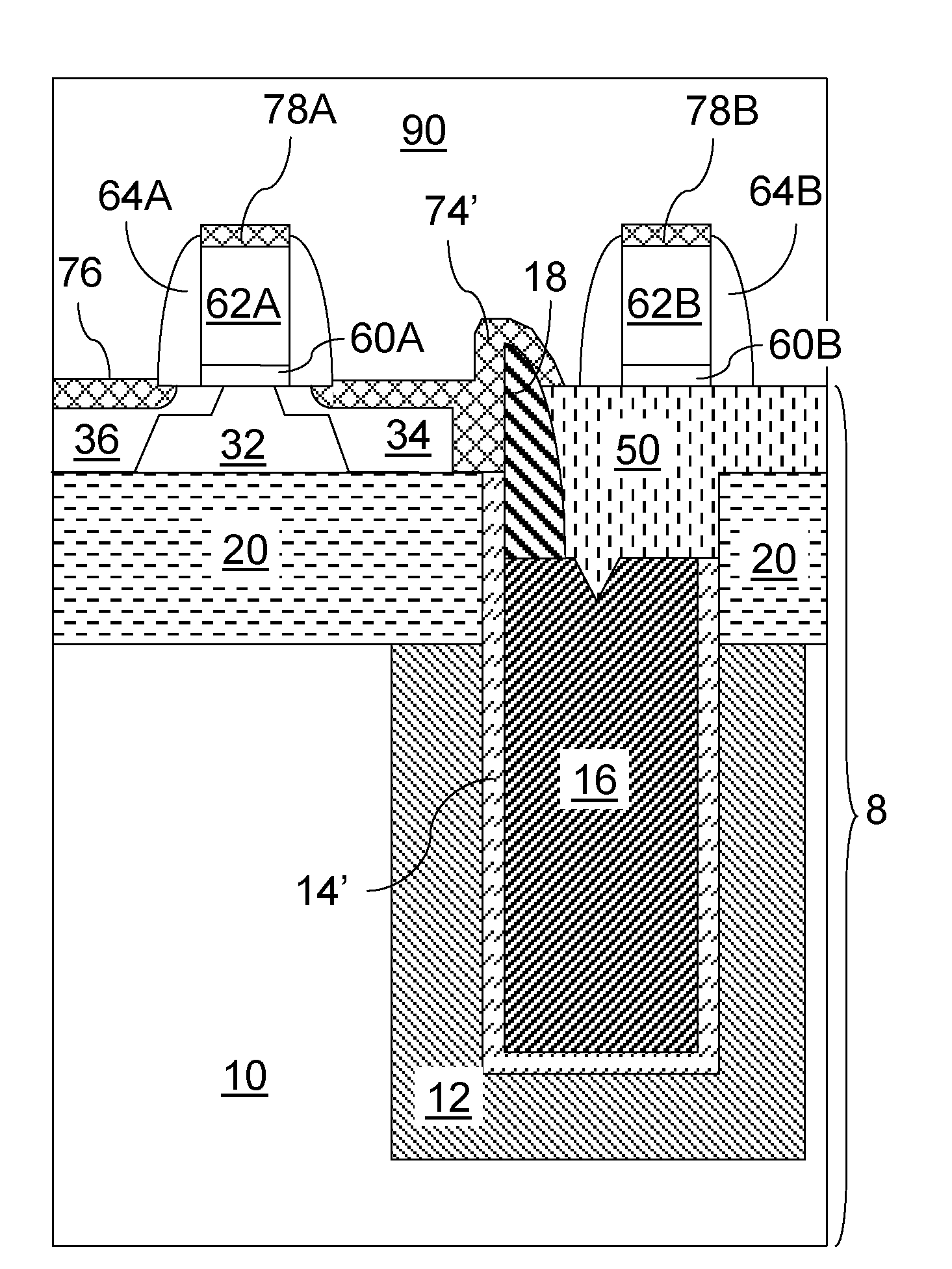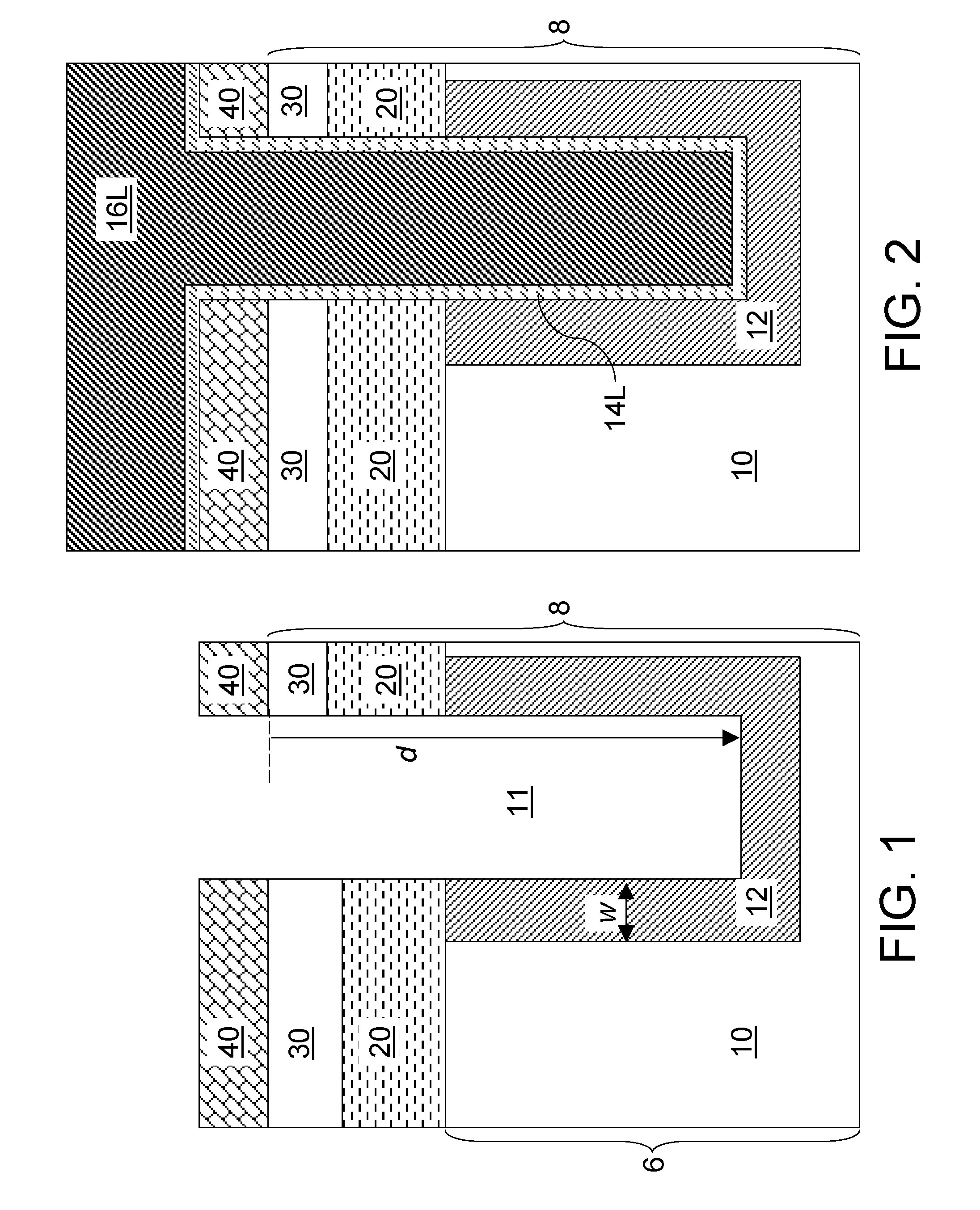Metallized conductive strap spacer for soi deep trench capacitor
a technology of conductive straps and capacitors, applied in the direction of semiconductor devices, electrical equipment, transistors, etc., can solve the problems of reducing the thickness of the top semiconductor layer, affecting the operation of the semiconductor, and presenting a difficulty in the formation of buried straps employed
- Summary
- Abstract
- Description
- Claims
- Application Information
AI Technical Summary
Benefits of technology
Problems solved by technology
Method used
Image
Examples
first embodiment
[0056]Referring to FIG. 1, a first exemplary semiconductor structure according to the present invention comprises a semiconductor-in-insulator (SOI) substrate 8 containing a top semiconductor layer 30, a buried insulator layer 20, and a bottom semiconductor layer 6. Each of the top semiconductor layer 30 and the bottom semiconductor layer 6 comprises a semiconductor material. The semiconductor material of the top semiconductor layer 30 and the semiconductor material of the bottom semiconductor layer 6 may be the same, or different. The semiconductor materials for the top semiconductor layer 30 and the bottom semiconductor layer 6 may be selected from, but is not limited to, silicon, germanium, silicon-germanium alloy, silicon carbon alloy, silicon-germanium-carbon alloy, gallium arsenide, indium arsenide, indium phosphide, III-V compound semiconductor materials, II-VI compound semiconductor materials, organic semiconductor materials, and other compound semiconductor materials. Typic...
fourth embodiment
[0097]Referring to FIG. 20, a fourth exemplary semiconductor structure according to the present invention is derived from the third exemplary semiconductor structure of FIG. 18. The divot 19 is subjected to an isotropic etch that removes the sidewall of the source region 34 by a lateral etch, thereby forming an expanded divot 19′ having a width greater than the thickness of the node dielectric 14′. A portion of the source region 34 and a portion of the drain region 36, including undercut portions underneath the active gate spacer portion 64B, may be removed by the etch employed to form the expanded divot 19′.
third embodiment
[0098]Referring to FIG. 21, various metal semiconductor alloy regions are formed by deposition of a metal layer and inducing reaction of the metal layer with underlying portions of a semiconductor material. Unreacted portions of the metal layer are subsequently removed. An active gate metal semiconductor alloy region 78A, a passing gate metal semiconductor alloy region 78B, and a drain side metal semiconductor alloy region 76 are formed in the same manner as in the A strap metal semiconductor alloy region 74′ is formed directly on the top surface of the source region 34, the sidewall of the source region 34, the substantially vertical sidewall of the conductive strap spacer 18, and on the entirety of the exposed surfaces of the top portion of the conductive strap spacer 18 above the top surface of the source region 34, thereby completely filling the expanded divot 19′. Preferably, the strap metal semiconductor alloy region 74′ extends to the top surface of the buried insulator laye...
PUM
 Login to View More
Login to View More Abstract
Description
Claims
Application Information
 Login to View More
Login to View More - R&D
- Intellectual Property
- Life Sciences
- Materials
- Tech Scout
- Unparalleled Data Quality
- Higher Quality Content
- 60% Fewer Hallucinations
Browse by: Latest US Patents, China's latest patents, Technical Efficacy Thesaurus, Application Domain, Technology Topic, Popular Technical Reports.
© 2025 PatSnap. All rights reserved.Legal|Privacy policy|Modern Slavery Act Transparency Statement|Sitemap|About US| Contact US: help@patsnap.com



